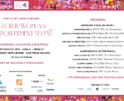
Email Excess

Here are 18 ways to lighten your inbox.
By Kathryn Whitbourne
The other day I was looking for an e-mail about a meeting change. It was hard to find because I had 970 emails in my in-box. And I’m not the only one. Most executives I speak with average about 100 pieces of e-mail per day.
“Before e-mail, the time burden was on the sender,” says Stever Robbins, email expert, executive coach and CEO of The Stever Robbins Co. “She had to write the letter, find the stamp and mail it, which forced her to consider if it was worth it. Now the burden is on the recipient.”
Robbins used to get 100 e-mails a day, but he now gets only 30. “I intentionally slow down the conversation,” he says. “I’ll answer now but schedule the message to go out in a few days. Also, my bounce back message says I don’t check e-mail very often and to call if it is important.”
Marilyn Paul, co-founder of Bridgeway Partners, an organization consulting group, and author of It’s Hard to Make a Difference When You Can’t Find Your Keys (Penguin, 2003), says e-mail has added one to two hours to each person’s day compared to 10 years ago. “E-mail should reduce work, not increase it,” she says.
With that in mind, here are 18 expert suggestions to keep e-mail from paralyzing you:
Recipients
• Take care of work before e-mail.
• Set up folders by client or topic; before storing an e-mail in a folder, ask, “When will I need it?” If you can’t answer that, delete.
• Use filters to capture important keywords, such as your boss’ name or a current project (in Outlook, look under “Tools” for the “Rules Wizard”).
• Use the preview page feature to view the message without opening it.
• Teach key people to put the main issue in the first two lines.
• Turn off that new e-mail bell.
• Look at e-mail only at set times each day; have it update only when requested (in Outlook, look under “Tools” for “Options” and then “Mail Setup”).
• As you read your e-mails, jot down the action items and incorporate them into your day’s to-do list.
• Don’t feel you have to respond immediately (or at all). Robbins says, “Ask yourself, ‘Is it worth $5 to reply?'”
Senders
• Keep messages short. If you can’t say it in four lines, pick up the phone.
• Don’t e-mail rebukes. E-mail should have zero tone of voice. Otherwise you run the risk of creating animosity (and more e-mail).
• Make the subject line a summary of your message (bad: “Meeting Rescheduled”; good: “Thursday Meeting Rescheduled for Friday”).
• Don’t cc everyone automatically.
• Make your action item clear at the beginning of the message.
• When e-mailing a group, ask that they only reply to the sender.
• Reread before sending to eliminate typos or misunderstandings.
• Avoid meaningless subject lines like “Urgent” or “Please Read.”
• Companies can come up with internal protocols (e.g., “NB 4/5” in the subject line means “Need Answer by April 5”).
This article originally appeared in the April.May 2006 issue of PINK Magazine.
Recommended
-
Fall 2024 EventNovember 19th, 2024
-
REGISTER HERE FOR THE UPCOMING...September 19th, 2024
-
Spring Sales Are Ready To Bloo...March 1st, 2024
-
Two Months Away!August 24th, 2023
-
Pink’s Signature Spring ...May 17th, 2023















